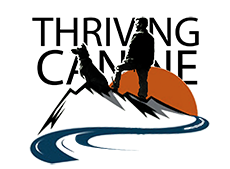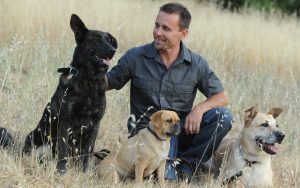Pet Partners Therapy Dog Evaluation Overview
Important Note: Thriving Canine is not affiliated with Pet Partners or any other Therapy Dog organization. This information is being provided for educational purposes only, primarily for our Canine Good Citizen students who might be interested in their dog becoming a Therapy Dog. We also practice some of these exercises in our Canine Good Citizen Class, the idea being that making the classroom practice harder makes the test easier. Or, maybe just think of it as extra credit.
There are two parts to the Therapy Dog test.
- Part 1 Skills Exercises: These are almost identical to the CGC test, minus the 3 minute separation.
- Part 2 Aptitude Exercises: These go beyond the CGC test, primarily in the area of social interactions and touching from the evaluators.
Everything below is copied directly from a Pet Partners document copyright 2016. As of 2025, I don’t think there have been any updates.
Skills Exercises for Dogs
Review the Handler’s Questionnaire Form
- You meet the team evaluator and the evaluator’s assistants.
- The evaluator reviews your handler’s questionnaire.
- You share with the evaluator how your dog signals to you that it needs a break or that it’s time to leave.
Accepting a Friendly Stranger
- You and the evaluator greet each other and shake hands.
- The evaluator looks at but doesn’t touch your dog.
- Your dog may change position but remains next to you.
Accepting Petting
- The evaluator approaches again and pets your dog on the head and body.
- The evaluator walks around behind your team and then returns to his or her starting place.
- Your dog willingly accepts petting while remaining next to you.
Appearance and Grooming
- The evaluator feels your dog’s coat and looks at its eyes, ears and toenails.
- The evaluator picks up and holds each front foot separately.
- The evaluator briefly brushes your dog in a natural manner.
- Your dog may change position but accepts handling.
Out for a Walk
- The evaluator explains what path to walk along.
- Your team will be asked to stop during the walk.
- Your dog does not need to heel perfectly but walks next to you on a loose lead with its attention on you.
Walk Through a Crowd
- The evaluator explains what path to walk along. Three assistants will walk through the area that you’re walking through. You proactively navigate the crowd. Your dog walks next to you on a loose lead with its attention on you; it may not approach for visits independently.
Reaction to Distractions
- The evaluator explains what path to walk along. There will be two distractions, a visual one in front of your team and an auditory one behind your team. Your dog walks next to you on a loose lead with its attention on you. You support your dog as needed. Your dog may express curiosity; if it startles, it recovers promptly.
Sit on Cue
- The evaluator directs you to have your dog sit.
- You can use a verbal and/or hand signal to ask your dog to sit.
- Your dog should be able to remain sitting for 3 seconds until you release it.
- Your dog may be in front of you or to your side.
Down on Cue
- The evaluator directs you to have your dog lie down.
- You can use a verbal and/or hand signal to ask your dog to lie down.
- Your dog should be able to remain down for 3 seconds until you release it.
- Your dog may be in front of you or to your side.
Stay in Place
- The evaluator provides a 10-foot long line and asks you to attach it to your dog.
- You put your dog in a sit, down or stand (your choice).
- You cue your dog to stay.
- You walk 10 feet away and then turn to look back at your dog.
- You pause 3 seconds and then return to your dog.
- Your dog may change position but stays.
Come When Called
- The long line is still attached to your dog.
- The evaluator distracts your dog by petting it.
- You walk 10 feet away, holding the long line.
- The evaluator cues you to call your dog.
- Your dog returns to you without distraction or delay.
- You reattach a standard leash and return the long line to the evaluator
Reaction to a Neutral Dog
- Your team is standing with an evaluation assistant.
- A neutral dog team enters the room and makes a short visit with another assistant.
- You support your animal as needed.
- As the neutral dog team leaves their visit, the two teams approach each other and pass approximately an arm’s length apart.
- Your team visits with the other evaluation assistant as the neutral dog team leaves.
- Your dog maintains its position next to you and does not show aggression or excessive fear.
Aptitude Exercises for Dogs
Overall Handling
- The evaluator makes eye contact with your dog and then exposes it to physical handling to assess its reaction to being touched in different areas; for example, the evaluator holds your dog’s tail, touches its ears, looks at its teeth and handles its feet.
- You facilitate the interaction and support your dog as needed. Your dog accepts handling.
Exuberant and Clumsy Petting
- The evaluator simulates petting by someone with limited mobility and poor motor skills.
- The evaluator also uses a high-pitched or squeaky voice and makes strange noises while interacting with your dog.
- You facilitate the interaction and support your dog as needed.
- Your dog willingly accepts petting.
Restraining Hug
- The evaluator makes eye contact with your dog and then leans over and gives it a full-body hug around the shoulders that restricts it for no more than 15 seconds.
- You facilitate the interaction and support your dog as needed.
- Your dog willingly accepts the hug.
Staggering and Gesturing Individual
- An assistant wearing a hat/robe and using healthcare equipment staggers, gestures with the hands and moans until he or she is 6 feet from your team.
- The assistant stops, calls your team to approach and pets your dog.
- You facilitate the interaction and support your dog as needed.
- Your dog willingly approaches and accepts petting
Angry Yelling
- Two assistants begin yelling at each other approximately 6 feet away from your team.
- The yelling is not directed at your team.
- The assistants stop yelling and become neutral, and one assistant calls your team to approach.
- You facilitate the interaction and support your dog as needed.
- Your dog willingly approaches and accepts interaction.
Two-Fingered Tap
- While you and your dog cross the room, the evaluator comes up from behind and gently taps your animal with two fingers on its side or back.
- You acknowledge the tap and support your dog as needed.
- Your dog may startle but recovers quickly.
Crowded and Petted by Several People
- Three assistants approach, one at a time, and begin touching your dog, until all three are gathered closely around, attempting to attract your dog’s attention.
- One assistant will be using healthcare equipment to approach your team.
- You proactively manage the crowd, facilitating interactions and supporting your dog as needed.
- Your dog willingly accepts petting.
Leave It
- The evaluator explains what path to walk along.
- The path will take your team past a toy on the ground, and your dog will pass within two feet of the toy.
- Your dog may not touch, pick up or mouth the toy.
- Looking and sniffing is acceptable.
Offered a Treat
- The evaluator walks toward your team with a treat in hand, saying, “May I give your dog a treat?”
- You get to decide whether your dog may have the treat. If you choose not to have the treat offered, this also means you will not allow treats to be given while visiting.
- If you allow the treat to be taken, you direct the evaluator how best to offer the treat; your dog takes the treat gently.
Chad Culp – Certified Dog Trainer, Canine Behavior Consultant, Owner of Thriving Canine.
© Thriving Canine 2025
We offer in-person training in the San Francisco Bay Area as well as virtual consults anywhere in the world.
Thriving Canine University private Facebook group. (please read the rules before joining)


